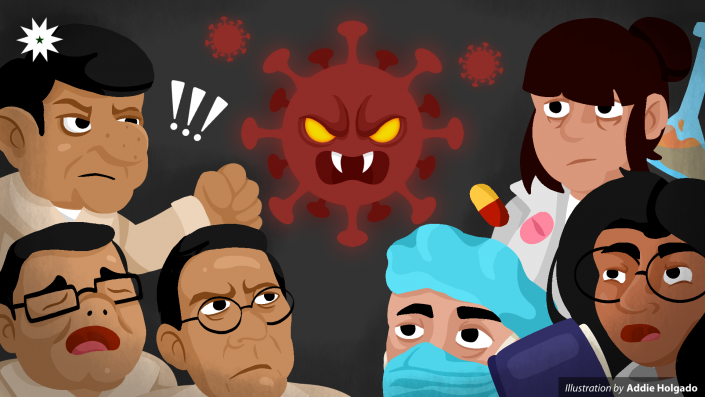A year and a half since enhanced community quarantine was first imposed on Metro Manila, the Philippines continues to suffer through what seems to be a quarantine roulette that has left in its wake mass confusion and unrest, with little to no respite.
With nearly 2.7 million recorded COVID-19 cases and almost 40,000 deaths since the onset of the pandemic, the impact that President Rodrigo Duterte’s administration has had in the fight against SARS-CoV-2 is clear.
In action
In 2014, late former President Benigno Aquino III signed Executive Order No. 168, which established the Inter-agency Task Force (IATF) for the Management of Emerging Infectious Diseases in the Philippines. This new task force was projected to be composed of high-ranking government officials that would “establish preparedness and prevent the spread of any potential epidemic in the Philippines.”
With the current pandemic, the IATF-National Task Force (IATF-NTF) has been spearheading initiatives to combat COVID-19 such as Task Force T3 (Test, Trace, Treat), a public-private initiative which aims to swiftly expand reverse transmission–polymerase chain reaction (RT-PCR) testing. Dr. Manuel Dayrit, a Task Force T3 member, discloses that they have also been “[focusing their] support on the roll out of the vaccination campaign.”
Meanwhile, one of the biggest referral hospitals for COVID-19 has been the Philippine General Hospital (PGH). University of the Philippines (UP) College of Medicine (UPCM) faculty member Dr. Gene Nisperos reveals that both professors and students of his university have been assisting in hospital operations. In fact, recent UPCM graduate Omid Siahmard has conducted teleconsultations for non-COVID patients to “ease hospital workload.”

Futile attempts
“The government somehow maintained control of policy and operations and did what it could to mitigate the disaster,” opines Dayrit. Despite these efforts, the government’s pandemic plan was plagued with a severe lack of preparedness, resources, and data.
Dayrit explains that virus detection was slow at the start of the pandemic. In fact, only one laboratory was capable of running RT-PCR testing in March of 2020. Data collection was disorganized, and analyses were performed late, he states. Contact tracing was “haphazard and feeble,” and hospitals could not cope with the increase in patients.
All this amounted to an overwhelming need to slow down virus transmission, ultimately leading to the lockdowns that the country is familiar with today. While lockdowns can reduce the rate of COVID-19 transmission, Dayrit emphasizes that they cannot completely eliminate the virus.
Nisperos claims that even the current amount of testing remains insufficient. With an average test positivity of over 20 percent as of press time, he stresses that the current 30,000 to 50,000 tests done daily fall short of the needed 200,000 daily tests.
Hospitals have also struggled with acquiring personal protective equipment for health workers and ventilators for hospitals. Lately, the Department of Health (DOH) reports nearly 70 percent utilization of hospital beds and around 60 percent utilization of ventilators nationwide. However, Nisperos asserts that hospital facilities are useless if they remain understaffed.
On the non-negotiables
Despite leading the charge, efforts from UP and its units have been neglected—with the DOH delaying the use of UP National Institute of Health-developed testing kits and Duterte disapproving the P100-million budget request for Philippine Genome Center laboratories in Visayas and Mindanao.
Siahmard posits that this administration has done little to alleviate the situation. Rather, it has intensified the pandemic due to failed leadership. “Devolved kasi ‘yung healthcare system natin…‘Yung mga mandato ng gobyerno sa national level, hindi yan masusunod sa LGU level, decentralized kasi,” he laments.
(The healthcare system is devolved; the mandates of the government at the national level cannot be followed by LGUs since power is decentralized.)
He emphasizes that what could have prevented the unmanageable rise in cases was to invest in testing, tracing, and isolation. However, “Hindi tayo nag-invest sa isolation centers…sa mas contextualized policies,” he remarks.
(We didn’t invest in isolation centers, in more contextualized policies.)
Siahmard mentions the importance of having contextualized policies to guide people, especially in the workplace, “Walang pangil ‘yung DOH policies, wala silang say, hindi nila kaya diktahan ‘yung mga corporations na ganito dapat yung polisiya sa loob ng korporasyon.”
(The DOH has no bite with regard to policies; they do not have a say in it. They do not have the capacity to dictate to corporations which policies they have to follow.)
People power
Instead of helping, the government is relentlessly handing out labels such as pasaway, and calling people choosy for rejecting certain vaccines. Angered, Nisperos addresses the government, “The Filipino people are your companions, not slaves,” he shares in Filipino.
Filipinos deserve nothing less than leadership that treats them with empathy and wisdom. Pertinent information about the virus must be accessible to the average Filipino through digestible dissemination of information in mass media.
The pandemic has led to unnecessary casualties—Filipino lives wasted because of the government’s incompetence. All the time ceaselessly spent on inadequate and inhumane policies has only led to longer lockdowns, insufficient hospital spaces, and distress for the poor.
However, it is no time to mourn over what could have been, but to demand more comprehensive strategies to combat the virus. After all, the least the government could do is to properly do its job.
